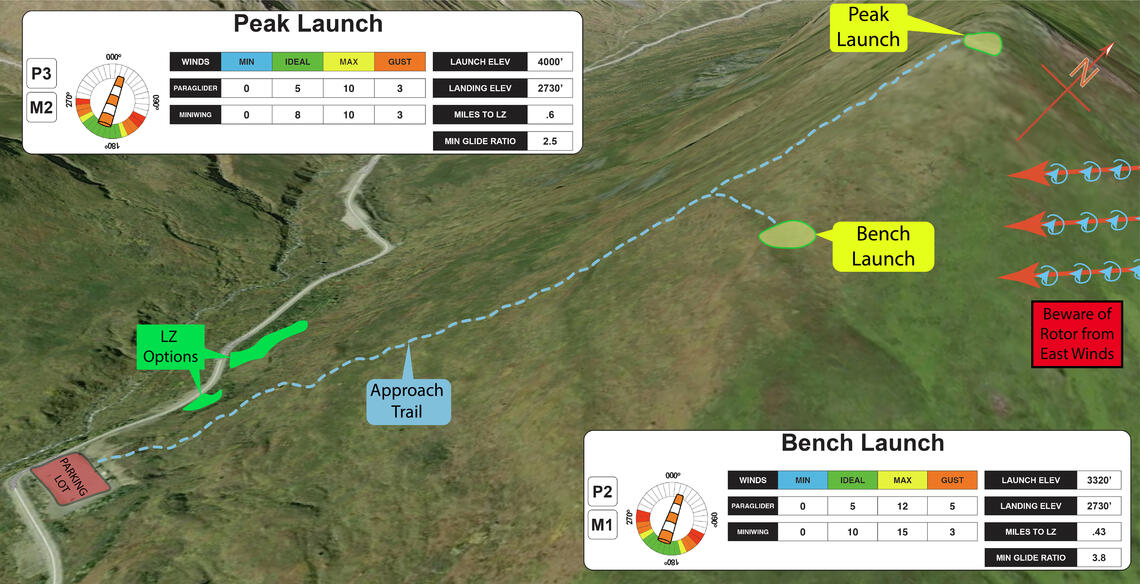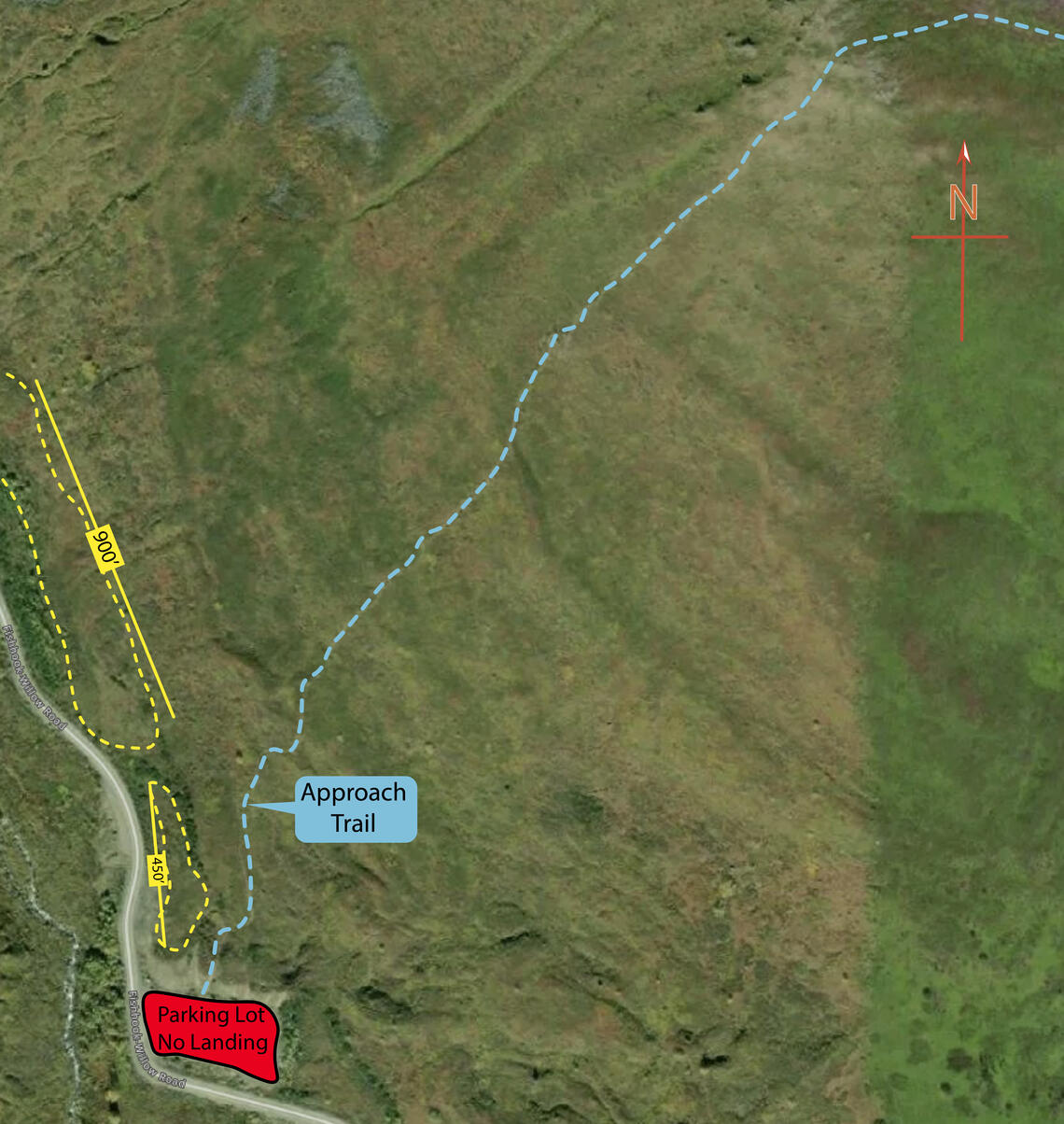Description
|
Pilot Recommendations
Bench Launch: P2/M1 Peak Launch: P3/M2 P3 skills recommended for XC flights
In person site intro recommended, especially for pilots flying XC |
Weather Conditions Bench Launch: Wind Direction: 140°-260° PG: Min:0mph/Ideal:5mph/Max:12mph/Gust:5mph MW: Min:0mph/Ideal:5mph/Max:12mph/Gust:5mph Glide Ratio to L/Z: 3.8 Peak Launch: Wind Direction: 140°-260° PG: Min:0mph/Ideal:5mph/Max:8mph/Gust:3mph MW: Min:0mph/Ideal:8mph/Max:10mph/Gust:3mph Glide Ratio to L/Z: 2.5 |
Hazards Beware of wind directions other than recommended. Too much east or west will create rotor along the face Overdevelopment is a major hazard while flying in Hatcher Pass. Cumulonimbus clouds extending above 30k feet are not uncommon There are converging, diverging, and mixing valley flows. Stay alert Strong valley flow winds are common in the afternoons. It is a good idea to have a backup LZ in mind When landing in tundra, beware of hummocks and marmot/ground squirrel holes that can easily cause ankle injuries |
|
Restrictions Do not land within 50' of other recreatorsDo not land on the road or in the parking lot. |
||
This site is not managed or maintained by the Arctic Air Walkers, and this Site Guide is provided to assist pilots in making good decisions about flying at this site.
Hatcher pass is one of the most popular flying areas during the summer in Alaska. It offers numerous launch options for nearly any wind direction and can provide both ridge lift or thermal soaring and sometimes it provides both at the same time. There are drive up launches and launches that require short hikes and long hikes. It has just about everything except trees. There is also untapped cross country potential but given the endless rugged terrain, the direction of travel options are somewhat limited.
http://en.wikipedia.org/wiki/Hatcher_Pass
Marmot is the somewhat obvious peak situated in the confluence of two valleys and offers several launch options which are accessed from the Fishhook trail head/parking lot. This is primarily a thermal site, though the thermal lift is often assisted by a strong valley flow that’s divided into two separate flows on face of Marmot.
From the parking lot you will have a view of both the Bench launch and the Peak launch. It is possible to see the windsock on the bench launch with binoculars.
Pilots are requested to NOT land in the Parking Lot, and instead to land in the tundra above the parking lot, or elsewhere in the tundra
Launch

The Marmot bench launch is about half way up the main trail to the summit ridge and provides an attractive alternative to the steep trail to the top. Follow the main trail until you're a little above a cliff face. A trail branches off to the right that leads directly to the bench launch. At the bench launch you'll find a nice fairly flat area to layout, with plenty of room to setup multiple wings. The bench site is mostly grass/tundra, and provides a great area to launch from. Launches are primarily from the south west facing slope which faces directly into the valley flow.
If you continue hiking up the trail past the cutoff for the Bench launch, you will reach the peak launch. This is a much smaller area, but does provide more options for a launch direction. It only advised to use this launch when conditions are light, and strong, mixing thermals converge from the various face creating turbulent conditions. This launch can also be used to get above an inversion layer.
Landing Zones
Marmot LZ
61.767376, -149.265454

The State Parks has asked that we not land in the Parking Lot. Instead land in the tundra above the parking lot, or on the tundra elsewhere.
There are two main landing area just to the north of the parking lot and east of the road. They consist of soft tundra, and make a great landing site. While relativly smooth, there may be hummocks and ground squirrel holes that could injure and ankle.
In strong winds, the field next to the A-frame lodge just up valley is a better landing option.
These are by no means the only landing options. There are many similar areas in the vicinity that make for great landing options aswell.
Other hikers/spectators/berry pickers may occasionally visit this site and the potential for a conflict exists. Pilots are cautioned to ensure an appropriate distance is maintained between launch and landing activities and the public. Pilots are expected communicate to the public as needed to maintain clearances.
Weather Considerations
Marmot generally works best when the winds aloft are light. South winds up to 10mph are doable when there's not much convection going on.
Pilots need to keep a careful watch on weather conditions, both on launch and in the air. Over-development is very common in Hatcher Pass, and cumulonimbus clouds extending above 30k feet are common. Strong valley winds can also occur on thermic days. It is not uncommon to become “parked” when coming in to land. Be aware, and have alternate LZ options in mind.
Wind Recommendations:
Beware of wind directions outside of the recommendations. Winds with too much east or west will create rotor along the face. It is also possible for it to be straight in at launch and north at the peak. This can create rotor in the air directly above launch. Check local weather stations for meteo winds.
Requirements
Pilots are expected to evaluate the launch, the possible landing areas, the weather, and other conditions. Flights are at the Pilot's own risk.
P2 is the recommended pilot level, with a P3 recommendation for pilots thinking to fly XC. Some instruction is done at the lower bench at this site under instructor supervision.
Modification or "grooming" of the trail and launch area is forbidden by the Park Service, and doing so could jeopardize further use of the area.
Hazards
- Other hikers/spectators/berry pickers may visit this site. Pilots are cautioned to ensure an appropriate distance is maintained between launch and landing activities and the public. Pilots are expected communicate to the public as needed to maintain clearances.
- This is a natural mountain site and there are many natural hazards that are common to many natural mountain sites in Alaska that could be a hazard for pilots.
- There may be no cell phone reception in many backcountry areas. Pilots are expected to be prepared for self-rescue and by carrying Spot, InReach or other non-cell based communication equipment.
- Massive over-development is one of the biggest hazards at Hatcher Pass. It’s very common for towering cumulonimbus clouds to blast into the sky past 30,000 feet. These clouds will suck you up, chew on you for hours, and spit your frozen corpse out somewhere in the remote and inaccessible Talkeetna Mountains. Be aware that this development can occur quickly above you and it’s not always obvious that it’s happening until it’s too late. Blue sky over the Matanuska-Susitna Valley doesn’t mean that you’re safe.
- There are a lot of converging, diverging, and mixing valley flows in the Hatcher Pass area. Stay alert.
- Winds can shift quickly. Be prepared.
- Pilots often try to fly along the east and west flanks of Marmot. If you choose to do this be aware of mechanical turbulence along the spines leading up mountain and be aware that the strong valley flows will probably make this a one way trip.
- Landing at the Mint Valley Trailhead often results in backwards landings because of the strong valley flow. It’s doable but not the best option.
- The State Parks has asked that we not land in the Parking Lot. Instead land in the tundra above the parking lot, or on the Tundra elsewhere.
WARNING: The descriptions of typical flying conditions listed in this Site Guide reflect the experience of the authors of the guide. The conditions that you encounter at the site may differ, sometimes substantially, from those described. These descriptions may not be relevant to the possible experience of any other pilot, particularly one who is relatively inexperienced or new to the Site.


